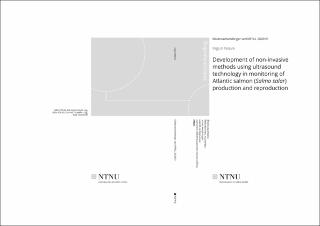| dc.contributor.advisor | Kjørsvik, Elin | |
| dc.contributor.advisor | Mommens, Maren | |
| dc.contributor.author | Næve, Ingun | |
| dc.date.accessioned | 2020-03-17T09:31:10Z | |
| dc.date.available | 2020-03-17T09:31:10Z | |
| dc.date.issued | 2020 | |
| dc.identifier.isbn | 978-82-326-4457-5 | |
| dc.identifier.issn | 1503-8181 | |
| dc.identifier.uri | http://hdl.handle.net/11250/2647114 | |
| dc.description.abstract | In production of Atlantic salmon (Salmo salar) broodfish, handlings for lice and disease management, gradings and checks for progression of sexual maturation, are inevitable. These handlings cause stress responses and can challenge fish welfare and reproductive outcome. Tools that can contribute to a reduction in the number of handlings that are required for successful broodfish production and make handlings gentler, are needed. The purpose of this thesis was to establish ultrasound technology as a non-invasive tool in Atlantic salmon broodfish production and reproduction.
This thesis presents a novel method for sex identification of Atlantic salmon parr (from 50 g body weight) using ultrasound technology (Paper I). We found that a high frequency ultrasound probe gave 95 and 97 % correct identification of males and females, respectively, and that parr had a good tolerance of the procedure. Sex identification can be performed concomitant to mandatory vaccination during the freshwater phase, to avoid adding extra handlings of fish. Thus, it is no longer necessary to handle broodfish candidates for sex identification during the seawater phase, which reduces handling stress and risk of escapes. In papers II and III we established a non-invasive method for estimation of gonado-somatic index in Atlantic salmon females and males, using ultrasound technology (US-GSI). The female US-GSI model is well-suited for monitoring of sexual maturation, while the male US-GSI model can be a tool for maturation monitoring when observations of testis appearance (echogenicity) in ultrasound images are added. This method eliminates the need for sacrifice of broodfish or relying on GSI from deceased fish for maturation monitoring. Using the US-GSI method established in Paper II in broodfish where sexual maturation has been advanced by light and temperature control, we found that females expected to ovulate early and late in the stripping season could be identified in July (Paper IV). In the weeks leading up to ovulation we observed changes in oocyte echogenicity and found that this could be used to predict ovulation time. Using US-GSI in July to separate females that are expected to ovulate early and late, females that are expected to ovulate early can be checked for ovulation while not disturbing females that are expected to ovulate late. This procedure for broodfish management can potentially reduce number of stressful handlings of females during a period when they are sensitive to the influence of stress on reproduction.
The ultrasound methods developed here can be used to establish a monitoring system that reduce handling of Atlantic salmon in seawater and in freshwater close to stripping. Such a system could also ease production planning and simplify broodfish handling logistics. These results also inspire further work to develop and refine the methods for maturation monitoring in Atlantic salmon using ultrasound. | nb_NO |
| dc.language.iso | eng | nb_NO |
| dc.publisher | NTNU | nb_NO |
| dc.relation.ispartofseries | Doktoravhandlinger ved NTNU;2020:51 | |
| dc.relation.haspart | Paper 1:
Næve, M. Mommens, E. Kjørsvik.
Sex identification of Atlantic salmon (Salmo salar)
juveniles using ultrasound technology | |
| dc.relation.haspart | Paper 2:
Næve, Ingun; Mommens, Maren; Arukwe, Augustine; Kjørsvik, Elin.
Ultrasound as a non-invasive tool for monitoring reproductive physiology in female Atlantic salmon (Salmo salar). Physiological Reports 2018 ;Volum 6:e13640.(9) s. 1-13
https://doi.org/10.14814/phy2.13640
This is an open access article under the terms of the Creative Commons Attribution License (CC BY 4.0) | |
| dc.relation.haspart | Paper 3:
Næve, Ingun; Mommens, Maren; Arukwe, Augustine; Virtanen, Jonni; Hoque, Md Emdadul; Kjørsvik, Elin.
Ultrasound as a noninvasive tool for monitoring reproductive physiology in male Atlantic salmon (Salmo salar). Physiological Reports 2019 ;Volum 7.(13) s. 1-12
https://doi.org/10.14814/phy2.14167
This is an open access article under the terms of the Creative Commons Attribution License (CC BY 4.0) | |
| dc.relation.haspart | Paper 4:
Næve, M. Mommens, A. Arukwe, E. Kjørsvik, Predicting ovulation and optimal
stripping time in Atlantic salmon (Salmo salar) using non-invasive ultrasound technology
to reduce handling stress | |
| dc.title | Development of non-invasive methods using ultrasound technology in monitoring of Atlantic salmon (Salmo salar) production and reproduction | nb_NO |
| dc.type | Doctoral thesis | nb_NO |
| dc.subject.nsi | VDP::Matematikk og Naturvitenskap: 400::Basale biofag: 470 | nb_NO |
| dc.description.localcode | Digital full text not available | nb_NO |

